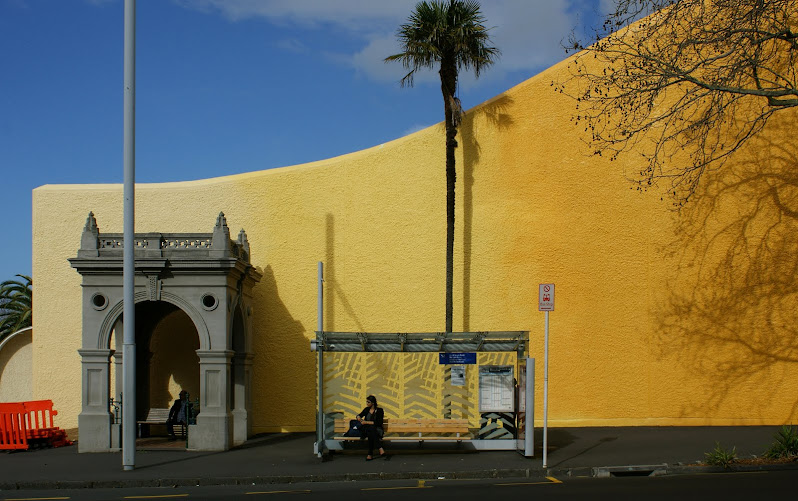 Back in the 1980s, France was developing nuclear warheads, with regular underground tests at Moruroa Atoll, French Polynesia. The atoll was gradually cracking and leaking radiation into the sea.
Back in the 1980s, France was developing nuclear warheads, with regular underground tests at Moruroa Atoll, French Polynesia. The atoll was gradually cracking and leaking radiation into the sea. NZ was an unofficial leader of the growing global anti-nuclear movement. In July 1985 the Greenpeace flagship Rainbow Warrior was in Auckland, NZ, preparing for a protest mission to Moruroa...but the voyage was not to be.
The French government, wanting to stop Greenpeace's protest, sent a large team of saboteurs to sink the Warrior: "Opération Satanique" was carried out by the 'action' branch of the French foreign intelligence services - the Direction Générale de la Sécurité Extérieure (DGSE) - late in the evening of July 10, 1985...
 The first limpet mine exploded under the engine room, blasting a hole the size of a car. Everyone was ordered off the ship but photographer Fernando Pereira went back to get his precious cameras. There was a second explosion and, caught in a rush of water, Pereira drowned. He had just celebrated his 35th birthday.
The first limpet mine exploded under the engine room, blasting a hole the size of a car. Everyone was ordered off the ship but photographer Fernando Pereira went back to get his precious cameras. There was a second explosion and, caught in a rush of water, Pereira drowned. He had just celebrated his 35th birthday.The NZ police, reacting swiftly to their first act of terrorism, were soon questioning two high-ranking French agents of the DGSE, while the rest of the team managed to escape – some by yacht and later submarine. France, an ally (!!!) of NZ, initially denied involvement and condemned the "terrorist act", but it was soon obvious they were involved. The French Defence Minister resigned and the head of the DGSE was fired. "Opération Satanique" was a public relations disaster.
Six weeks later, the agents' pre-trial hearing was dramatically shortened by a French threat: an economic embargo of NZ's exports to Europe if the pair was not released. Such an action would have crippled the NZ economy, as it was then so dependent on agricultural exports. In 1986, France agreed to pay NZ$13 million to NZ and apologise: in return the pair would be detained at a French military base on Hao Atoll in French Polynesia. But the two were released in less than two years. As this violated the agreement, the French had to pay further reparations.
The failure of NZ's Western allies to condemn what could be considered an act of war by France caused a change in foreign and defence policy. NZ distanced itself from its traditional ally USA, and built relationships with smaller South Pacific nations, while keeping excellent relations with Australia and, to a lesser extent, the United Kingdom.
 No-one else has ever been charged over the bombing and death, although all the team members' identities are known: 20 years later, a French Intelligence report said the attack was authorised by French President François Mitterrand. Justice has never fully been served for Fernando Pereira but his memory continues to inspire those who fight for a cleaner world.
No-one else has ever been charged over the bombing and death, although all the team members' identities are known: 20 years later, a French Intelligence report said the attack was authorised by French President François Mitterrand. Justice has never fully been served for Fernando Pereira but his memory continues to inspire those who fight for a cleaner world. And what happened to the Rainbow Warrior? Two years after the bombing, she reached her final resting place under Matauri Bay, in Northland. Resting at 27m depth, she has become a living reef, attracting marine life and divers: a fitting end for a ship that spent her time protecting the marine environment.
 NZer David Robie, aboard the ship that fateful night, wrote Eyes of Fire: The Last Voyage of the Rainbow Warrior in 1986. And you can read an article about that fateful night and the aftermath here.
NZer David Robie, aboard the ship that fateful night, wrote Eyes of Fire: The Last Voyage of the Rainbow Warrior in 1986. And you can read an article about that fateful night and the aftermath here.




1 comment:
The capture and release of the French agents who bombed the Greenpeace ship, Rainbow Warrior was not the end of the affair. This film documents the circumstances of the crime...(free to watch online)
http://www.nzonscreen.com/title/when-a-warrior-dies-1991
Post a Comment